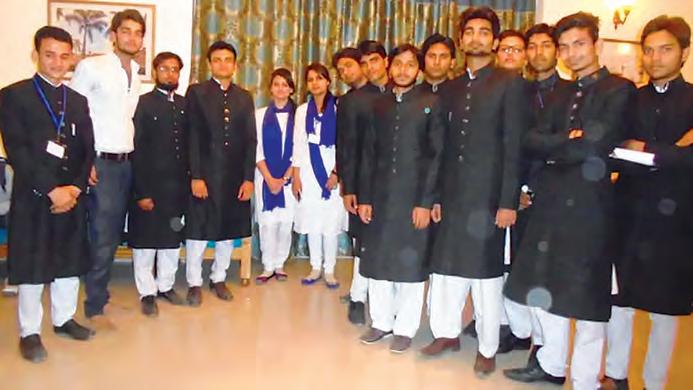
9 minute read
Iconic Muslim University Marks Centennial
Iconic Muslim University Marks Centennial The Aligarh Muslim University stands as testimony to Sir Syed’s quest for reforms in education and a fulcrum for Muslims in South Asia
BY IFTIKHAR GILANI
Advertisement
Last December, Muslims of South Asia and beyond Qasim Nanatvi, while agreeing to make education a tool to celebrated a landmark — the centenary of Aligarh re-empower Muslims, had serious differences on the Muslim University, which has gained a global nature of education. reputation for academic excellence. Concerned with the imperialists’ mass killing
The real story started nearly 150 years ago in of religious scholars (ulema), Nanatvi (1832-80) the red sandstone building of the Delhi Madrassa left Delhi in 1866 for Deoband village. He started (now the Anglo Arabic Model School) at Ajmeri imparting religious lessons under a pomegranate Gate, where the old and new city of Delhi meet. tree to produce scholars who could lead mosques Here Molvi Mamlook Ali’s two students were often and guide people to sustain religious values and seen fiercely debating how to revive the Muslims’ principles. Out of this grew Darul Uloom Deoband, glory in the Subcontinent. the world-famous seminary considered the mother
Hopelessness and despondency crept among of South Asia’s madrassas. Muslims after the British ended their 800-year rule Sir Syed Ahmad Khan Ten years later, Syed Ahmad (1817-98) also left and targeted them. Delhi and, in 1875, set up the Anglo Mohammedan
Coinciding with the mighty Mughal Empire’s dissolution and College on the pattern of Cambridge and Oxford in Aligarh, 150 miles the failure of the first war of independence against the British in southeast of Delhi. Braving fierce community opposition — he was 1857, both students, [later Sir] Syed Ahmed Khan and Maulana actually labeled an infidel — he introduced modern education and


AMU students in formal attire
made learning English compulsory. He envisioned a crop of committed Muslims who were comfortable with modern science and the industrial world — scholars who could lead their community and dialogue with the West. but it has also become a part of their aspirations woven into culture and identity.
AMU has produced distinguished alums: five heads of states in Pakistan and one each India, Bangladesh and the Maldives; former
Like their founders, the two institutions have remained poles apart in terms of conduct and response to social and political developments. In later years, Aligarh’s alum (Alig; Aligarian), at ease with English, were in the forefront of demanding a share of political power. Many of them supported the demand for what, in 1947, would become Pakistan.
But at Deoband, kifaya-clad teachers and students fervently supported the Indian National Congress and remained its loyalists until 1992, when the events leading to the 700-year old Babri Mosque’s demolition forced them to seek refuge elsewhere. To this date, these two groups have refused to seek a middle ground.
In December 1920, The Anglo Mohammedan College was upgraded to a university. Although India’s Muslims now fare much worse than the lowest, Dalits (Untouchables) and other weaker sections, the iconic Aligarh Muslim University (AMU) has preserved their ancestors’ past grandeur and splendor. Not only does it provide a window of opportunity to Indian Muslims, Indian vice-president Hamid Ansari; and four chief ministers of the erstwhile Muslimmajority state of Jammu and Kashmir. According to international ranking agencies, AMU is ranked fourth in the nation in terms of the excellence and quality of its educational programs.
Since its inception, AMU students have been quite receptive to international political developments. According to University of Texas professor Gail Minault, Aligarh college students fasted and saved money to raise 13,900 Ottoman lire (nowadays $5 million) for the Turkish relief fund to help the Ottoman Empire during the 1912-13 Balkan War (“The Khilafat Movement: Religious Symbolism and Political Mobilization in India,” Columbia University Press, 1982).
Dr. Ahmed Mukhtar Ansari, a physician-turned-political activist, made Aligarh the center of his activities to garner support. He later headed a 23-member volunteer medical mission that helped the empire during WWI. Members included students like Chaudhry Khaliquzzaman (a future top politician of Pakistan) and Abdul Rahman Peshawari (aka Abdurrahman Bey). This member of the wealthy Samdani family later helped found the global Turkish Anadolu Agency news agency and was appointed Turkey’s first ambassador to Afghanistan soon after WWI by Mustafa Kemal Ataturk.
Khaliquzzaman reminisced that Ansari had approached him during a tennis practice session and convinced him to help: “In the evening I was packing my baggage to join Ansari’s medical mission to leave for Istanbul,” he writes in his memoir “Pathway to Pakistan” (Pakistan: Longmans, 1961).
BID TO MAKE AN AMU REPLICA IN TURKEY Since the British were stalling about upgrading Aligarh to a university, Ansari, who later became president of the All India Muslim League as well as the Indian National Congress, proposed establishing this university abroad until India achieved independence. Burak Akcapar, a senior Turkish diplomat, recalls that Ansari had convinced Sultan Mehmet V and the endowments minister to allot 65,000 acres of land near Ankara’s railway station and 25,000 acres at Adana and Konya (“People’s Mission to the Ottoman Empire: MA Ansari and the Indian Medical Mission, 1912–13,” Oxford University Press, 2014).
Akcapar records that Ansari had written to Maulana Mohammad Ali Jouhar, the top Muslim and Khilafat Movement leader, that this university would be a cornerstone of an Islamic renaissance. He had suggested that Jouhar consult scholars such as Shibli Nomani and Sir Muhammad Iqbal to form a committee to draft its curriculum. But the proposal was overtaken by events, as WWI started and Ansari and his medical team had to return to India.
Spread over an area of 1,000 acres, AMU currently enrolls 30,000 students, maintains a staff of 11,000 academics and non-academics and offers 350 different courses.
This area, located west of the Aligarh railway station along with the “Civil Lines” housing development known as the university area, houses residences for professors, former staff members and the Muslim elite. Over time, rich Muslims have also settled in the area. In fact, this is perhaps the only North Indian region where one can see clean localities with proper civic amenities and recall the Muslims’ past glory.
Although Aligarh scholars have expertise
in modern education, along with a genuine Muslim identity and character, they also have many faces. Kerala governor Arif Mohammed Khan and Samajwadi Party leader Azam Khan represent a bitter ideological rivalry. Historian Irfan Habib represents its high scholarship. Noted actor Nasiruddin Shah brings up a manifest talent. Zahida and Sajida Zaidi have showcased the assertion of gender equality.
Alum heart specialist Dr. Hanif Baig, who is also a professor at its medical college, was declared an outstanding scientist a few years ago. Hafeezu-Rahman’s research on cancer and its relation with alcohol received international acclaim. Dr. Rafatullah received has objected to using “Muslim” in its name, claiming that doing so violates India’s secular ethos and that an institution that gets government money cannot identify itself with any religion. But they do not object to using “Hindu” in Banaras Hindu University. In 2015, Prime Minister Modi’s government told the Supreme Court that it does not consider AMU a minority institution. Ending its minority status would be a big blow to Indian Muslims, whose educational backwardness is documented in official statistics. Only 11% of Muslim children acquire a higher education. The figure for Hindus and Christians is 20% and 31%, respectively. The government and ruling party leaders argue

Strachey Halll a lifetime achievement in medicine award from the Indian government for classifying 250 medicinal herbs that are now used in 395 medicines. Bushra Atiq received the most coveted 2020 Shanti Saroop Bhatnagar award for scientific research.
AN EYESORE FOR ISLAMOPHOBES The Indian Council of Medical Research (ICMR) chose Aligarh University Medical College for its anti-coronavirus vaccine trial. AMU ranks fourth in India and its medical college ranks ninth.
While a section of India’s media often blows out of proportion even insignificant incidents that may occur there, the ruling Bharatiya Janata Party leaders have described the university as a threat to national security. Their patron organization, the extreme right-wing Rashtriya Swayamsevak Sangh, that the British — not the Muslims — set up this university in 1920 by an act of Parliament and that the Anglo Mohammedan College was upgraded to university status.
Ironically, Modi used AMU as a prop by attending its centennial and having his government issue a postage stamp.
This is not the first time that AMU’s minority character has been targeted. In the 1960s, using an incident of student protest, Education Minister M. C. Chagla — ironically a Muslim — enacted a law ending its minority status. Later in 1981, Prime Minister Indira Gandhi restored its character through an act of Parliament. In 2005, the Allahabad High Court struck down this law. But then the Manmohan Singh government challenged it in the Supreme Court, which ruled in favor of its minority character. The case is still pending before the court. UNIVERSITY CULTURE Over the years, the university has developed its ethos and philosophy — known as Aligarh culture — on three pillars: taaleem (education), tehzeeb (culture) and tarbiyat (training). It seeks to nurture people whose mission of education and scientific vision is not only socially alive but also practically emphatic.
For special occasions, male students dress in a black sherwani (a long coat buttoned along its length). A senior student is expected to guide juniors, even to help them financially if necessary. Even after graduation, a junior cannot pull out his wallet in a senior’s presence. The strong Aligarh alumni communities spread all over the world affirms the lasting bond of respect and affection produced by the unique culture.
AMU still stands testimony to Sir Syed’s quest for reforms in education and a fulcrum for South Asia’s Muslims. But grappling with the South Asian Muslims’ existential threat and identity crisis, it strives to produce leaders and visionaries to lead them. Its grandeur and splendor continue to exist in the verses of its famous alum, Urdu poet Asrarul Haq Majaz, which was adopted as AMU’s anthem:
Every night is the night of Egypt here, every evening in the evening of Shiraz here.
The garden encompasses lyrics and tunes of the whole world.
The sky has come down many times to kiss the dust of this land.
We have seen with our own eyes, the utter defeat of vanity.
This is my garden; my garden, and I am the nightingale of my garden. ih
Iftikhar Gilani, editor (planning) in Turkish global wire Anadolu Agency, Ankara, is a senior journalist who has reported from the Indian capital New Delhi for over the past 25 years for many national and international media outlets.












